The latest Richardson CARES class graduated Oct. 25. Richardson CARES (Citizens Academy & Resource Education Series) offers residents and other stakeholders an operational behind-the-scenes look at Richardson’s municipal government. Participants are briefed on various municipal programs, projects and services such as public safety, public utilities, parks and administration. They are provided opportunities to have behind-the-scenes looks at several facilities and operations by holding meetings at various locations.
To help the community learn more about CARES, participants in this year’s program shared their thoughts on each session.
Session One: City Manager, City Secretary, Budget and Human Resources
In Session One, participants heard from City Manager Dan Johnson, City Secretary Aimee Nemer and Budget Officer Bob Clymire, and also viewed a video highlighting the Human Resources Department.
Johnson spoke briefly about the history of Richardson before talking about the Council-Manager form of government. He also touched on the City’s strong financial position and Triple A Bond Rating, as well as the tools the City uses to attract and retain businesses.
The Office of the City Secretary has a wide range of responsibilities, which Nemer spoke about. Some of these duties are records management, supporting the City Council, administering local elections, and coordinating the Richardson CARES program. Nemer also shared that along with the tax collector, the role of the City Secretary is the oldest public service role in local government, dating back biblical times.
Fresh off the passing of the 2021-22 City of Richardson Budget in late August, Clymire provided an overview of the entire budgeting process and the different operating funds in the City budget. He also touched on how the two-person Budget Department provides multi-year financial projections and assists all other departments with budgetary issues.

1. What did you find most interesting about Session One?
Diane Orr: The budget process.
Pat Byars: The responsibilities of the City Manager and the City Secretary.
2. Before Session One, were you familiar with what the City Manager and City Secretary did?
Julie Lu: No, I wasn’t aware of all the duties and responsibilities of the City Manager and City Secretary. After meeting them and hearing them speak, it was obvious that Dan and Aimee love what they do and are working hard for the citizens and businesses of Richardson.
3. What is one thing you learned about the budgeting process that you didn’t know before the class?
Jennifer Bates: I didn’t realize that the budget was set to zero each year. I have a much better understanding of the City’s revenue and budgeting process.
4. What are you most looking forward to during Richardson CARES?
Grace McIntyre: I am looking forward to all the other sessions. More Richardson residents need to be exposed to all this information. I wish had been more knowledgeable about the workings of the city during all the years I have been here.
Session Two: Richardson Police Department and Municipal Court
In Session Two, participants heard from Police Chief Gary Tittle and Municipal Court Administrator Kimberly Kierce. The session took place at the Public Safety Campus, which participants were given a tour of.
Tittle spoke about the history of the department, beginning with the appointment of its first chief in 1955. He also gave an overview of the organizational structure, crime watch patrols and the importance of volunteers. He also touched on the department’s new Crisis Intervention Team and how Intelligence-Led Policing can assist in preventing crime.
Kierce gave an overview of the Municipal Court and where it falls in the structure of the Texas judicial system. She also shared the Court’s primary functions and spoke about how the Court adjusted to COVID-19, which included additional safety protocols, using more online forms and phone payments, and utilizing Zoom.
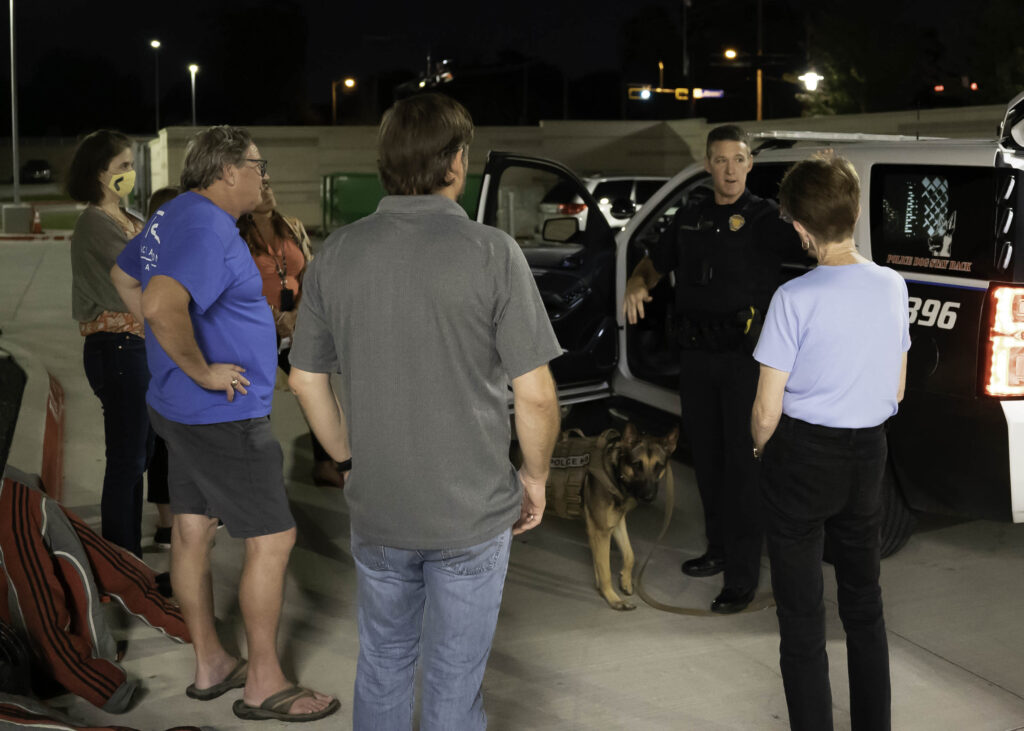
1. The new Police Headquarters was part of the 2015 Bond Program. After receiving a tour, what do you think of the new facility?
Diane Orr: Spacious and impressive! Our police deserve this.
Jennifer Bates: I imagine other cities will look to Richardson’s new Police Headquarters as a source of innovative inspiration.
Micki Webb: I thought the new Police Headquarters was fabulous! Beautifully designed and yet functional.
2. One of the Police Department’s newest units is its Crisis Intervention Team. What are your thoughts on this team? Do you think it will be successful in its mission?
Pat Byars: The Crisis Intervention Team is an excellent idea. It should be helpful in controlling situations where mental illness is involved. Liked the linking with Methodist Hospital—excellent idea.
Grace McIntyre: Crisis intervention sounds great. Needs advertising. Citizens must be aware of it for success.
Julie Lu: The Crisis Intervention Team seems to address a great need to efficiently triage and follow-up for situations involving mental health crises. It would be interesting to see the data and outcomes in a couple years to see the impact of this team.
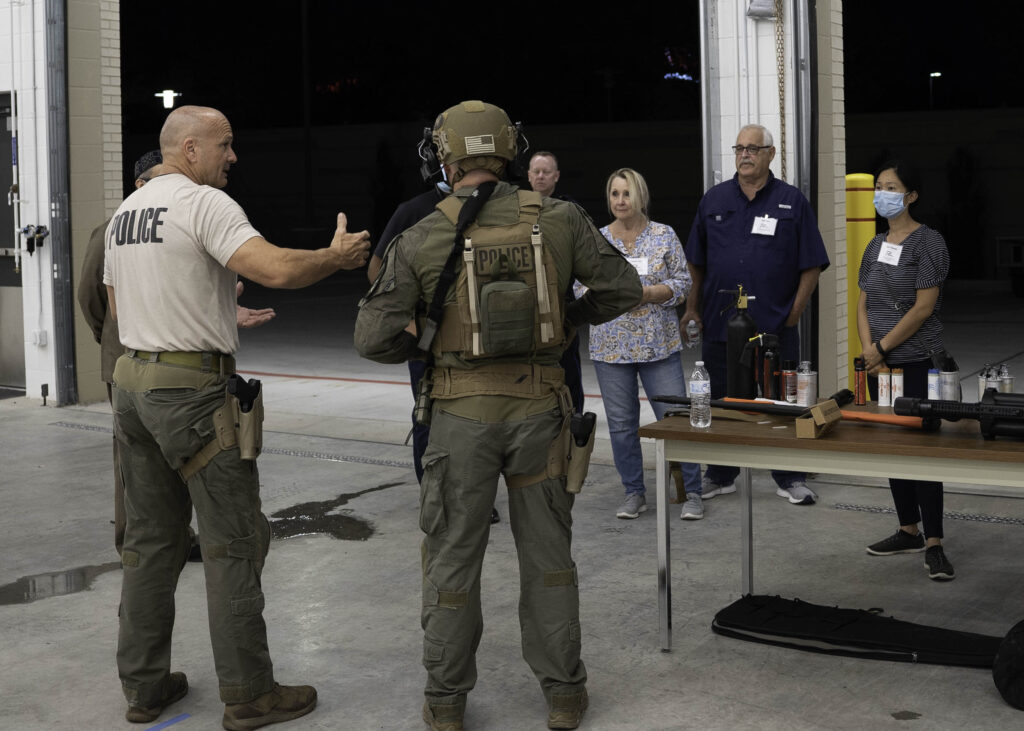
3. The Police Department has a number of ways for residents to get involved including Volunteers in Police Service, Neighborhood Crime Watch, and the Explorers program. Do you think it is important for the community to be involved in making Richardson a safer place? Why or why not?
Micki Webb: Greater participation and awareness from the community is essential for increased safety. The question is how do you target citizens and what information is necessary to encourage those with the desire and time to volunteer?
Pat Byars: I do think it is important that the community be involved as volunteers with the police department. Volunteers provide “free” help to the department and saves hiring additional manpower. It is good PR to see volunteers providing various services.
Diane Orr: Absolutely. Citizens getting to know our police officers and working together to provide a better, safer city is a win-win for us all.
4. What was one interesting thing you learned about the Municipal Court?
Grace McIntyre: All new to me. As old as I am, I should know more. Was not aware part of fine goes to state.
Jennifer Bates: I was impressed by the daily volume of court cases.
Julie Lu: Anyone can request a trial by jury, even if it is just for a parking ticket.
Session Three: Development Services and Transportation and Mobility
In Session Three, participants learned about the Development Services and Transportation and Mobility departments.
Sam Chavez, interim director of Development Services, spoke about his department, which works closely with two of the City’s boards and commissions, the City Plan Commission and the Zoning Board of Adjustment.
The department is responsible for oversight of the comprehensive planning process and administration of the zoning process and other land use related functions. It also reviews zoning proposals and requests for zoning and fence variances; conducts demographic analysis and special studies; and manages all activities associated with formulating and implementing the City’s long-range comprehensive plan. It also reviews development proposals, including plats, site plans, landscape plans and civil engineering plans.
Mark Nelson, director of the Transportation and Mobility Department, spoke about transportation in Richardson including the City’s relationship with DART, which operates light rail services, bus routes and shuttles in Richardson. Nelson also spoke about the City’s status as a Bicycle Friendly Community and what the department does to improve pedestrian connections. Nelson also gave an overview of traffic management and traffic signals before leading the class on a tour of the City’s Traffic Management Center, which is housed at the Service Center.
1. The Development Services Department shared a snapshot at Richardson’s demographics. How have you seen Richardson change as its population grew from when you moved here to its current figure of nearly 120,000 people?
Jennifer Bates: We moved to Richardson from another North Texas town about eight years ago and one of the primary reasons we chose Richardson was because the city is demographically diverse.
Grace McIntyre: Since I moved to Richardson it has grown from a small rural town to a city atmosphere. Traffic has increased many fold. Diverse nationalities are abundant. Neighbors are not as emotionally close. Stores have come and gone. Real estate prices have increased threefold.
2. Richardson’s comprehensive plan looks 10-20 years into the future. What would you like to see happen in Richardson over the next two decades?
Pat Byars: Better control of speed. Try to find somewhere to have another park. To continue to work on making areas pleasant to take families. The increase of bus service and trains better accommodate the needs of the citizens.

Micki Webb: Over the next 20 years, I would like to see another grocery store added to our community and any upgrades needed to be provided. I would also like to see the Richardson Square area utilized better. Perhaps add a Central Market type store.
3. DART’s Silver Line rail project is decades in the making. What do you think the impacts will be to Richardson residents and business owners?
Grace McIntyre: The Silver Line will bring more people of diverse nationalities.
Jennifer Bates: Upon completion, I hope residents will be encouraged to take advantage of a less stressful, more environmentally friendly ride to/from the airport.
4. Richardson is a bicycle friendly community with an extensive network of bike and pedestrian trails. What do you think are the benefits of this network of trails?
Pat Byars: The trails have taken away the second lane for traffic. In looking at the numbers that are using the bike trails along resident streets, it appears that the need of the areas for traffic far exceed the need for bicycles.
Micki Webb: I walk a minimum of 4 miles daily and use the Huffhines Trail. I have gotten to know many new neighbors and enjoy the outdoors. We are so fortunate to live in Texas and enjoy good weather most of the time. I feel safe walking here and the area is maintained regularly. This trail is large enough to accommodate bikers, runners and walkers with pets. As an exercise physiologist, I know the benefits of exercise and would encourage more Richardson residents to take advantage of the “free” trails.
Session Four: Parks and Recreation, Richardson Library and Eisemann Center
In Session Four, participants learned about Parks and Recreation, the Library and the Eisemann Center.
Parks Director Lori Smeby spoke about her department, which not only manages Richardson’s several dozen parks, but also oversees community events, the Senior Center, aquatics, athletics and the Convention and Visitors Bureau. After learning about what the department focuses on, class members were placed into small groups and brainstormed their own park.
Library Director Jennifer Davidson talked about the Richardson library, which this year is celebrating its 62nd anniversary. The Library is much more than just books, with programs designed for everyone from infants to senior citizens. These programs include classes to familiarize people with the Library’s 3D printer, as well as computer programs such as Microsoft Office and the Adobe Creative Suite. The Library also houses a large local history selection, including maps and photographs from the early years of Richardson.
The evening wrapped up with a behind-the-scenes tour of the Eisemann Center, the City’s 19-year-old performing arts venue which has hosted thousands of events and millions of visitors since its opening in 2002.
1. Community events are a big part of the Parks and Recreation Department. What is your favorite community event and why?
Julie Lu: Our family really enjoys the annual Trash Bash. It’s a great way to come together as a community to take care of our city, and also encourage beautifying our own neighborhoods since the city also provides free mulch and compost!
Micki Webb: I enjoy Wildflower and the Cottonwood Art Festival. Both are held during the time of year when the weather is nice and it is fun to get out and walk the grounds enjoying the music, food and the variety of arts and craft works. You never know what unexpected gems you will find!
2. During CARES Session Four you learned about what the Parks and Recreation Department offers and then designed your own park. What types of amenities did you put in your park and what did you name your park?
Micki Webb:Our table team (Mason, Mohamad, Jennifer, Grace and me) designed a park for the inner city with retail stores on three sides and the fourth a major highway. The amenities we added included:
It seems like there were a few more items but I cannot recall them without looking at the diagram. We named it Grace Park. Grace has been a long-time resident of Richardson. I think over 50 years!!
Julie Lu: Working with my group to design our own park was one of my favorite parts of this session! Our park was called Rose Garden Park. We created this space for people to enjoy and destress during their breaks and lunchtime while at work. Some of the amenities included a trail around the park centered around a fountain and rose garden to encourage people to get some exercise while enjoying the outdoors. We also included several shaded picnic tables that doubled as chess boards so people could also take a mental break with coworkers. Lastly, we also included a basketball court to also encourage coworkers to get to know one another better while being active.
3. The Eisemann Center has hosted several million people since opening in 2002, but most people never get to see behind the scenes. What did you think of your behind-the-scenes tour?
Grace McIntyre: Tour of the building was great!! The director gave wonderful presentation.
Pat Byars: The tour was wonderful and the descriptions of the backstage areas was interesting, particularly how well the separate stages are sound proofed. I found the information about always leaving the light on was interested. The gentleman who lectured was interesting and did an excellent job.
4. What services does the Library offer that you were not familiar with?
Julie Lu: We love the library and take our kids there at least once every week. It was exciting to learn that I can book a librarian who can help with researching my family history and genealogy.
Micki Webb: I think I was born with a book in my hand! I read all the time and utilize the on-line services the library provides to check out books and movies. I was impressed with the number of in-house activities and programs provided for both children and adults. I did not know about the assembled kits and laptops you could check out. The behind-the-scenes automated book return process was impressive. I like the easy check out system. It is fast and efficient.
Session Five: Fire Department and Emergency Management
The fifth session of Richardson CARES took place at the Fire Training Center where participants learned about the Fire Department and the City’s Office of Emergency Management.
Fire Chief Curtis Poovey shared a bit about the history of the department. It purchased its first ambulance in 1950, at which time became one of the first cities in Texas to have an ambulance. The department began to pay its firefighters in 1963. At that time four of its firefighters had “first aid training,” compared to today when all 161 firefighters are certified paramedics.
The Office of Emergency Management has a staff of four who are tasked with organizing and leading the city’s response during emergencies, such as after the October 2019 tornado. Deputy Emergency Management Coordinator Scott Greeson spoke about during emergencies OEM helps bring together all city departments to ensure everyone is on the same page. He also detailed how the City’s response would not be possible without partnerships with local businesses, nonprofits and other local and state governmental agencies. He concluded his presentation by leading CARES participants through a mock emergency scenario where they worked through what would happen before, during and after a tornado.
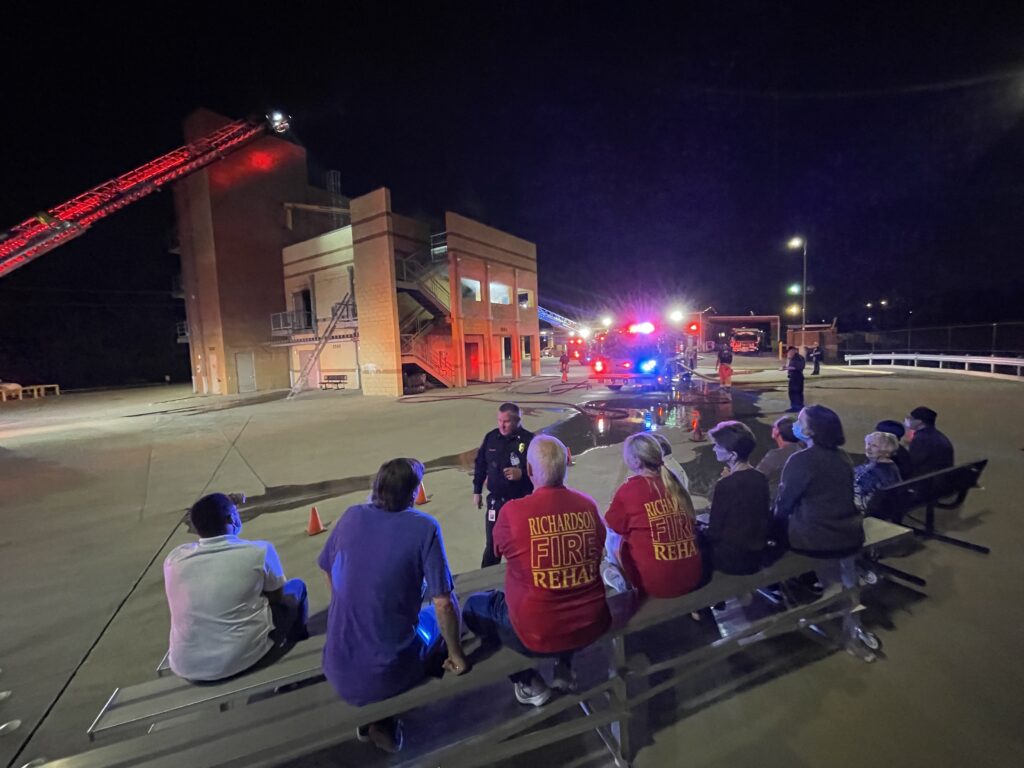
1. The Richardson Fire Department has come a long way since its founding in 1926. What did you learn about the Fire Department?
Grace McIntyre: Very impressed with our FD. Had no idea of their training. I think we are in good hands
Micki Webb: I learned that the training to become a fireman is very extensive. Not only learning how to extinguish many types of fires, but also knowledge to medically assist or save a person’s life. I also learned that an arson investigator must be trained as a police officer and as a fire fighter with additional other training. Also, that women were fire fighters. I did not know that the fire trucks carried water to extinguish a fire in addition to all the hoses for the hydrants.
Pat Byars: The outstanding training the members of the fire department receive and the equipment provided.
2. What were your thoughts on the Fire Training Center?
Grace McIntyre: The training center is great. The exercise they did for us was exciting.
Micki Webb: The training center was a large, nice looking facility with an impressive mock “burning” apartment building in the rear. I liked the secluded location near a park trail. I also noticed the named bricks at the entrance. Nice touch. It was impressive to watch a live action rescue and see how quickly the entire team jumped into action and made certain all were safe and accounted for.
Pat Byars: The organization and excellent facilities.
3. What did you learn during the tornado emergency exercise?
Grace McIntyre: I will pay more attention to the siren!! Their plan for school shooting sounds good. I believe that’s more likely to happen than other disasters.
Micki Webb: I learned that you have less than 13 minutes to prepare for a tornado and that everyone needs to have a plan of where to go in your home for safety and what supplies are necessary to have in an “Emergency Bag” to bring with you. I also learned there are more tornados per year in Texas than in Oklahoma.
4. During the Emergency Management presentation OEM staff spoke about the importance of being prepared during an emergency. What lessons did you learn about preparedness that you will implement into your daily life?
Grace McIntyre: This was very good class. And I liked the fire chief also.
Micki Webb: This presentation brought home the fact to get all the necessary paperwork and supplies ready in a “grab bag” ready to take at a moment’s notice and do it NOW! Very considerate of the organization to give us all the information and stuff to make it easy to put together.
Session Six: Public Services and Engineering & Capital Projects
In Session Six, participants learned about Public Services and Engineering & Capital Projects. Class members learned about the different divisions that make up the Public Services Department. These divisions handle work ranging from maintaining 600 miles of streets and alleys to ensuring the City’s stormwater infrastructure stays in good shape. The department also supervises and maintains Richardson’s water distribution and sanitary sewer systems and collections trash, recycling and brush and bulky items.
The City’s Engineering & Capital Projects Department is also broken into several different divisions. The department works closely with Public Services, handling the design and construction of the water distribution, stormwater drainage and sanitary sewer systems, as well as the design and construction of the City’s streets, alleys and sidewalks. Members of the department also act as the flood plain administrators for the City’s system of creeks, ensuring water is adequately drained. The department also is responsible for maintenance on the 60 city-owned facilities and takes a lead role in the administration of voter-approved bond programs.
1. Facilities Maintenance is just one division in the Engineering and Capital Projects Department. Which city facilities do you use and enjoy the most?
Grace McIntyre: Definitely everyone uses water and sewer most. Was impressed with two persons keeping an eye on water supply and water pressure 24 hours per day. Drainage and creeks are monitored and prepared for big rains. Sewers can be cleaned as needed.
Micki Webb: The city facility that I use most frequently is the Library. I am a voracious reader an enjoy the wide variety of books and DVDs available. And of course, the Eisemann Center since I volunteer there and the Huffhines Park fitness center and trail.
2. Richardson received several inches of rain this week. What did you learn about the stormwater and drainage systems and how they help prevent severe flooding?
Grace McIntyre: If I need my water turned off call water department. Not fire station.
Jennifer Bates: I’m amazed at the expansive network of underground channels that take away our stormwater.
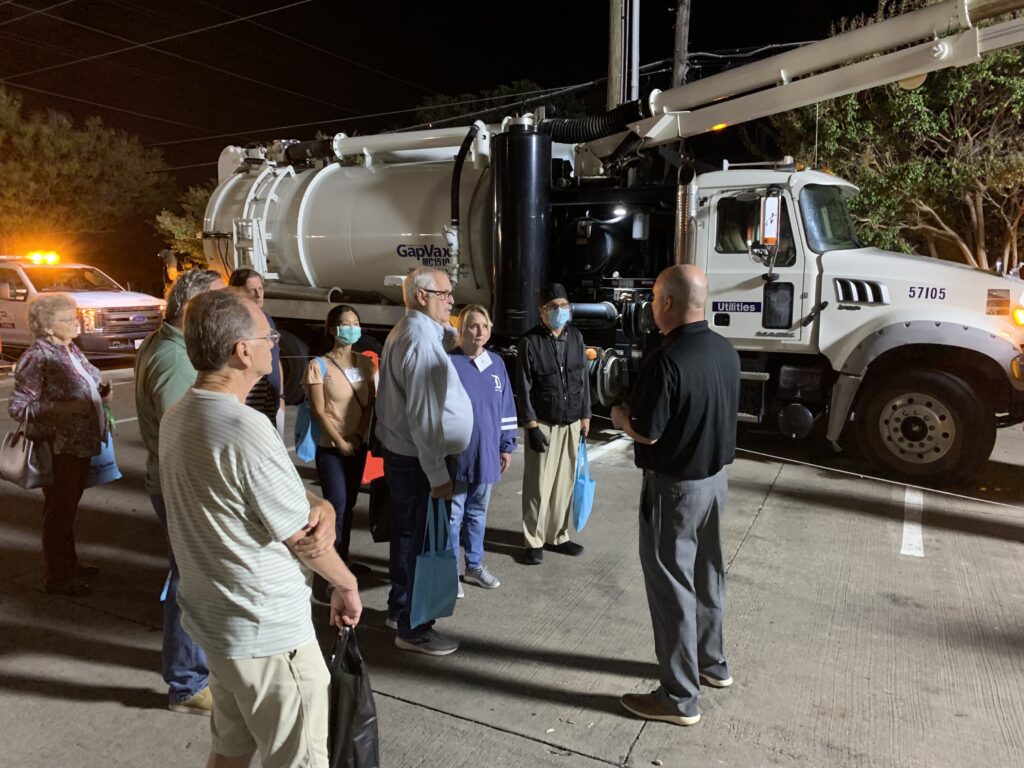
3. The Service Center houses several different city departments including Public Services and Capital Projects. What did you think of the building?
Jennifer Bates: Anyone who has the opportunity to visit the Service Center will see that Richardson has eyes on all parts of the community 24/7. They are able to monitor our city using innovative technology.
Micki Webb: The building was attractive from the outside. I found it impressive that they could house so many large vehicles without being noticed. I did not see that much of the interior of the building but I was surprised to learn that two staff members manned the water towers, etc. 24/7.
4. What did you learn about the work that Public Services crews do before, during and after severe weather events?
Grace McIntyre: Workers in those departments are on the job before and after severe weather. I am pleased to know of all the city does for safety and comfort of residents. I am glad I live in Richardson. All this has happened while I’ve been in the city and I did not know what was going on.
Jennifer Bates: They are first responders and well-prepared to help our city before, during and after bad weather.
Micki Webb: I learned that the men and women who are employed in this division of city government work very hard in a coordinated fashion to protect the health and safety of the city resident’s and business’s. This is an ongoing circular process of being prepared for simple repairs to severe weather related damage. WOW!!
Session Seven: Communications, Health and Community Services
In Session Seven, participants learned about Communications, Health and Community Services. Class members learned about the different communications channels used by the city to get information to residents. These channels include traditional media such as Richardson Today and videos produced by Citizens Information Television, as well as new media channels such as Facebook, Instagram, Twitter and YouTube.
The Health Department shared information about what the different divisions inside the department do, including inspecting restaurants, trapping and spraying mosquitoes to prevent the spread of West Nile virus, and helping organize community cleanups through the Community & Corporate Environmental Cleanup Program.
Community Services spoke about common code violations, and class members took a quiz to see how many code violations they could identify.
1. Session Seven took place at the newly renovated Senior Center. What did you think of the facility?
Grace McIntyre: The Senior Center is a gorgeous facility. I personally make use of the equipment (all new) in the exercise room almost every weekday. A brief tour would have been a good idea.
Pat Byars: The facility is wonderful. I wish we had taken some time to tour the facility. It appears to have enough room to offer space for many events and should be easy to keep clean.
2. The Communications Department uses a number of communications channels to reach residents. How do you primarily city receive information?
Jennifer Bates: I primarily read Richardson news through the monthly newsletter we receive in the mail. Nextdoor also has good information.
Micki Webb: I mostly receive my information about the city through the Richardson Today newsletter. However, since our class, I will use the other medias mentioned.
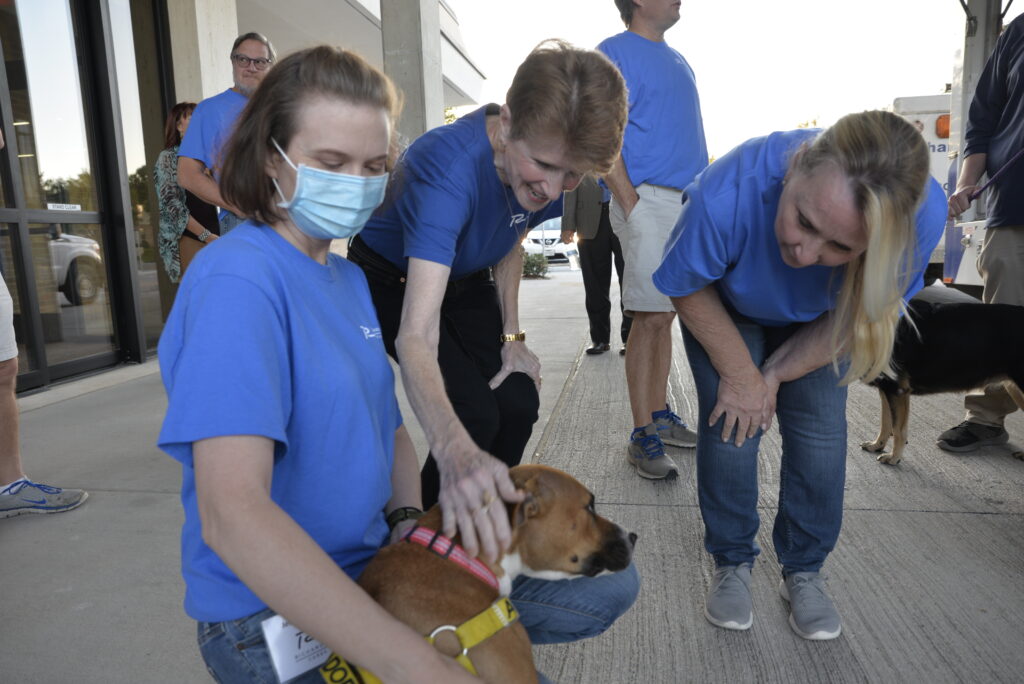
3. The Health Department Power Point presentation was certainly memorable. What are you going to remember most about the presentation?
Jennifer Bates: I could have listened to a dozen more stories from the Health Department. Please don’t store chicken in the beverage ice!
Pat Byars: The effort that is taken to protect us as consumers. The opportunity to contact employees of the Health Department.
4. You learned about several city programs that allow residents to give back to their community. What type of impacts do you think programs like the Volunteer Assistance Program and Corporate and Community Cleanup?
Grace McIntyre: I am a big proponent of volunteering. I volunteer at the Library. Volunteers gain a personal interest in what’s going on.
Micki Webb: Both the Volunteer Assistance Program and the Corporate and Community Cleanup Program are essential to sustain a clean and visual attractive city.




